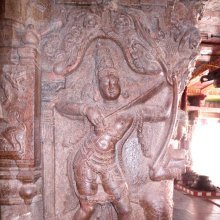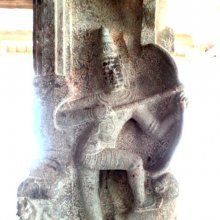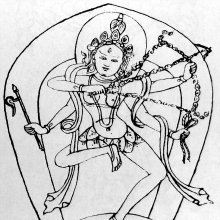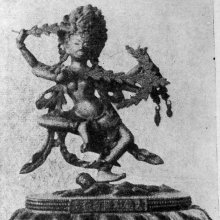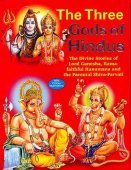Kamadeva, Kāmadeva, Kama-deva: 20 definitions
Introduction:
Kamadeva means something in Buddhism, Pali, Hinduism, Sanskrit, Jainism, Prakrit, Hindi. If you want to know the exact meaning, history, etymology or English translation of this term then check out the descriptions on this page. Add your comment or reference to a book if you want to contribute to this summary article.
Alternative spellings of this word include Kamdev.
Images (photo gallery)
In Hinduism
Purana and Itihasa (epic history)
Source: archive.org: Puranic EncyclopediaKāmadeva (कामदेव).—See under Kāma.
Source: Cologne Digital Sanskrit Dictionaries: The Purana Index1a) Kāmadeva (कामदेव).—The form in which Hari reveals himself to Lakṣmī in the continent of Ketumāla.1 Fought with Durmarṣa in a Devāsura war.2 Overlord of all Apsaras and ṛtus3 (see kāma); as part of the gift of kalpapādapa.4
- 1) Bhāgavata-purāṇa V. 18. 15.
- 2) Ib. VIII. 10. 33.
- 3) Brahmāṇḍa-purāṇa III. 8. 15.
- 4) Matsya-purāṇa 277. 6. Vāyu-purāṇa 70. 14.
1b) The son of Yaśodharā (Yaśodhāri, Vāyu-purāṇa.).*
- * Brahmāṇḍa-purāṇa II. 11. 35; Vāyu-purāṇa 28. 30.

The Purana (पुराण, purāṇas) refers to Sanskrit literature preserving ancient India’s vast cultural history, including historical legends, religious ceremonies, various arts and sciences. The eighteen mahapuranas total over 400,000 shlokas (metrical couplets) and date to at least several centuries BCE.
Kavya (poetry)
Source: Shodhganga: The Kavyamimamsa of RajasekharaKāmadeva (कामदेव) is the name of an important person (viz., an Ācārya or Kavi) mentioned in Rājaśekhara’s 10th-century Kāvyamīmāṃsā.—One of the eighteen disciple of Kāvya-puruṣa. According to Rājaśekhara he was composed the gratification-śāstra (Binod śāstra). However it is not confirmed that he was the Kāmadeva or the any other Ācārya.
Source: OpenEdition books: Vividhatīrthakalpaḥ (Kāvya)Kāmadeva (कामदेव) is the name of a merchant, as mentioned in the Vividhatīrthakalpa by Jinaprabhasūri (13th century A.D.): an ancient text devoted to various Jaina holy places (tīrthas).—Accordingly, “The merchant Kāmadeva becomes a lay faithful after having listened to Mahāvīra in Campā. One day, a god of false belief decides to test him. He first takes the form of a monstrous Piśāca and threatens three times to tear Kāmadeva to pieces, if he does not give up the practice of the Law. [...]. After the sermon, Mahāvīra evokes the upasarga of Kāmadeva and praises his courage: he is an example to follow for monks who must be at least at the level of a layman”.
Cf. Uvāsagadasāo Hoernle 1890 I (text) p. 45-66, II (translation) p. 64-89; Āvaśyakacūrṇi I 454.9-455.2 (short version); Triṣaṣṭiśalākāpuruṣacaritra X.8. v. 265-275: Johnson VI p. 208-209 (includes only the episode of Kāmadeva's conversion to Jainism).

Kavya (काव्य, kavya) refers to Sanskrit poetry, a popular ancient Indian tradition of literature. There have been many Sanskrit poets over the ages, hailing from ancient India and beyond. This topic includes mahakavya, or ‘epic poetry’ and natya, or ‘dramatic poetry’.
Ayurveda (science of life)
Source: archive.org: Vagbhata’s Ashtanga Hridaya Samhita (first 5 chapters)Kāmadeva (कामदेव) is the father of Hemādri: the author of the Āyurvedarasāyana: a commentary on the Aṣṭāṅgahṛdayasaṃhitā: one of the three great works of Vāgbhaṭa.—Hemādri was the son of Kāmadeva, grandson of Vāsudeva, and great-grandson of Vāmana. Besides the Caturvargacintāmaṇi and Āyurvedarasāyana, he wrote several other works (Śrāddhapaddhati, Hemādriprayoga, Nānāśāntayaḥ, Tristhalīvidhi) and commentaries (on Vopadeva’s Muktāphala and Śaunaka’s Pravaṇakalpa); but he is different from Bhaṭṭa Hemādri, the son of Īśvarasūri and author of the Raghuvaṃśadarpaṇa.

Āyurveda (आयुर्वेद, ayurveda) is a branch of Indian science dealing with medicine, herbalism, taxology, anatomy, surgery, alchemy and related topics. Traditional practice of Āyurveda in ancient India dates back to at least the first millenium BC. Literature is commonly written in Sanskrit using various poetic metres.
General definition (in Hinduism)
Source: WikiPedia: HinduismKamadeva is the Hindu god of human love or desire. He is the son of the Hindu goddess Sri.
Puranas: In some Kamadeva arises from the mind of the creator god, Brahma: in others he is the son of Sri. Kamadeva is sometimes portrayed as being at the service of Indra: one of his names is "obedient to Indra".
One of the principal myths regarding Kama is that of his incineration by Shiva. It occurs in its most developed form in the Matsya Purana (verses 227-255) but is also repeated with variants in the Shaiva Purana and other Puranas.
According to the text Shiva Purana, Kamadeva is a son or a creation of Brahma, while according to other sources including the Skanda Purana, Kamadeva is a brother of Prasuti; they are both the children of Shatarupa, a creation of Brahma. Later interpolations consider him the son of Vishnu Kamadeva is wed to Ratī, the daughter of Daksha, created from his sweat.
Iconography: Kāmadeva is represented as a young, handsome winged man with green skin who wields a bow and arrows. His bow is made of sugarcane with a string of honeybees, and his arrows are decorated with five kinds of fragrant flowers.
Etymology: Kāmadeva (Sanskrit in Devanagari: कामदेव), (Bengali: কামদেব), also called Māra. The name Kama-deva (IAST kāma-deva) can be translated as 'god of love'. Deva means heavenly or divine. Kama (IAST kāma) meaning "desire" or "longing", especially as in sensual or sexual love.
Other names for him include;
- Manmathudu (Telugu: మన్మథుడు)
- Atanu (Telugu: అతను) (one without a body),
- Ragavrinta (stalk of passion),
- Ananga (incorporeal),
- Kandarpa (inflamer even of a god),
- Madan "Manmatha" मन्मथ
- Manmadha (churner of hearts),
- Manasija {he who is born of mind}, a contraction of the Sanskrit phrase Sah Manasah jāta),
- Madana (intoxicating),
- Ratikānta (lord of Rati),
- Pushpavān,
- Pushpadhanva,
- Kusumashara कुसुमशर (one with arrow of flowers)
- or just Kāma (longing).
In Buddhism
Mahayana (major branch of Buddhism)
Source: Wisdom Library: LokottaravādaKāmadeva (कामदेव) is the name of a Buddha under whom Śākyamuni (or Gautama, ‘the historical Buddha’) acquired merit along the first through nine bhūmis, according to the Mahāvastu. There are in total ten bhūmis representing the ten stages of the Bodhisattva’s path towards enlightenment.
Kāmadeva is but one among the 500 Buddhas enumerated in the Mahāvastu during a conversation between Mahākātyāyana and Mahākāśyapa, both principle disciples of Gautama Buddha. The Mahāvastu is an important text of the Lokottaravāda school of buddhism, dating from the 2nd century BCE.

Mahayana (महायान, mahāyāna) is a major branch of Buddhism focusing on the path of a Bodhisattva (spiritual aspirants/ enlightened beings). Extant literature is vast and primarely composed in the Sanskrit language. There are many sūtras of which some of the earliest are the various Prajñāpāramitā sūtras.
In Jainism
General definition (in Jainism)
Source: Google Books: Jaina IconographyKāmadeva (कामदेव) or the Cupid was an object of worship and temples of Kāmadevas existed in ancient India. The Jainas, too evolved a list of Kāmadevas, but their role was different. Behind the Jaina concept of a Kāmadeva, it is his extremely beautiful person that was emphasised and he had not the powers of shooting arrows on young men and women. Bāhubali, the great sage, was the first Kāmadeva.
Source: HereNow4u: Jain Dharma ka Maulika Itihasa (2)Kāmadeva (कामदेव) refers to one of the ten householders mentioned in the Upāsaka Daśā, one of the Dvādaśāṅgī (twelve Aṅgas) of Jainism.—As the name suggests 'uvāsagadasāo', the seventh Aṃga describes about the ten devotees (layman - householders). Its chapters are also ten, and so the name is appropriate. It has 1 Śruta skaṇdha, 10 chapters, 10 topics and 10 sub topics. It comprises of thousands of verses. Presently the quantity of this Āgama is 812 verses (ślokas). Its ten chapters describe the life of individual votaries like Anand et al. pertaining to different castes and professions [i.e., Kāmadeva].
Source: academia.edu: Tessitori Collection IKāmadeva (कामदेव) or Kāmadevakathā refers to one of the 157 stories embedded in the Kathāmahodadhi by Somacandra (narrating stories from Jain literature, based on the Karpūraprakara), which is included in the collection of manuscripts at the ‘Vincenzo Joppi’ library, collected by Luigi Pio Tessitori during his visit to Rajasthan between 1914 and 1919.—The Kathāmahodadhi represents a repository of 157 stories [e.g., Kāmadeva-kathā] written in prose Sanskrit, although each of them is preceded by a verse. Together, they stage a large number of Jain characters (including early teachers). [...]

Jainism is an Indian religion of Dharma whose doctrine revolves around harmlessness (ahimsa) towards every living being. The two major branches (Digambara and Svetambara) of Jainism stimulate self-control (or, shramana, ‘self-reliance’) and spiritual development through a path of peace for the soul to progess to the ultimate goal.
Languages of India and abroad
Sanskrit dictionary
Source: DDSA: The practical Sanskrit-English dictionaryKāmadeva (कामदेव).—
1) the god of love.
2) Name of Śiva.
3) Name of Viṣṇu.
Kāmadeva is a Sanskrit compound consisting of the terms kāma and deva (देव).
Source: Cologne Digital Sanskrit Dictionaries: Edgerton Buddhist Hybrid Sanskrit DictionaryKāmadeva (कामदेव).—name of a former Buddha: Mahāvastu i.140.14.
Source: Cologne Digital Sanskrit Dictionaries: Benfey Sanskrit-English DictionaryKāmadeva (कामदेव).—m. the god of love, [Harivaṃśa, (ed. Calc.)] 270. Kāvya-devī, f. a proper name.
Kāmadeva is a Sanskrit compound consisting of the terms kāma and deva (देव).
Source: Cologne Digital Sanskrit Dictionaries: Cappeller Sanskrit-English DictionaryKāmadeva (कामदेव).—[masculine] the god of love.
Source: Cologne Digital Sanskrit Dictionaries: Aufrecht Catalogus Catalogorum1) Kāmadeva (कामदेव) as mentioned in Aufrecht’s Catalogus Catalogorum:—king of Jayantīpurī, patron of Kavirāja (Rāghavapāṇḍavīya). Oxf. 121^a.
2) Kāmadeva (कामदेव):—king, patron of Raghunātha (Satkṛtyamuktāvalī). L. 1664.
3) Kāmadeva (कामदेव):—son of Vāsudeva, grandson of Vāmana, father of Hemādri (Caturvargacintāmaṇi).
4) Kāmadeva (कामदेव):—poet. [Sūktikarṇāmṛta by Śrīdharadāsa] Mentioned in Bhojaprabandha Oxf. 150^b.
5) Kāmadeva (कामदेव):—astronomer. Rice. 28.
6) Kāmadeva (कामदेव):—son of Gopāla: Karmapradīpikā Pāraskarasūtrapaddhati. W. p. 65. Pāraskaragṛhyapariśiṣṭapaddhati. Proceed. Asb. 1869, 137.
7) Kāmadeva (कामदेव):—Dāyabhāganirṇaya.
8) Kāmadeva (कामदेव):—(?): Kāmasāra.
Source: Cologne Digital Sanskrit Dictionaries: Monier-Williams Sanskrit-English Dictionary1) Kāmadeva (कामदेव):—[=kāma-deva] [from kāma] m. the god of love (See kāma above; according to some, son of Sahiṣṇu and Yaśo-dharā, [Viṣṇu-purāṇa])
2) [v.s. ...] Name of Viṣṇu (as the god who creates, preserves, or destroys at will), [Viṣṇu-smṛti, viṣṇu-sūtra, vaiṣṇava-dharma-śāstra xcviii, 10] (cf. [Bhāgavata-purāṇa v, 18, 15])
3) [v.s. ...] of Śiva, [cf. Lexicographers, esp. such as amarasiṃha, halāyudha, hemacandra, etc.]
4) [v.s. ...] of a poet
5) [v.s. ...] of a king of Jayantī-purī
6) [v.s. ...] Name of the author of the Prāyaścitta-paddhati
[Sanskrit to German]
Sanskrit, also spelled संस्कृतम् (saṃskṛtam), is an ancient language of India commonly seen as the grandmother of the Indo-European language family (even English!). Closely allied with Prakrit and Pali, Sanskrit is more exhaustive in both grammar and terms and has the most extensive collection of literature in the world, greatly surpassing its sister-languages Greek and Latin.
Hindi dictionary
Source: DDSA: A practical Hindi-English dictionaryKāmadeva (कामदेव) [Also spelled kamdev]:—(nm) Cupid-the god of love.
...
Kannada-English dictionary
Source: Alar: Kannada-English corpusKāmadēva (ಕಾಮದೇವ):—
1) [noun] Kāma, the Love-God.
2) [noun] Śiva.
3) [noun] Viṣṇu.
4) [noun] name of a musical mode (now obs.).
Kannada is a Dravidian language (as opposed to the Indo-European language family) mainly spoken in the southwestern region of India.
See also (Relevant definitions)
Partial matches: Kama, Deva, Teva.
Starts with: Kamadeva kavivallabha, Kamadeva maharaja, Kamadeva mimamsakadikshita, Kamadevakatha, Kamadevamaya, Kamadevatva, Kamadevavatisarasamgraha, Kamatevan.
Ends with: Gunakamadeva.
Full-text (+370): Rati, Minaketana, Shukavaha, Ratipriya, Ratiramana, Ragalata, Pushpeshu, Hricchaya, Ratipati, Ragavrinta, Rupastra, Panceshu, Vishamayudha, Sankalpajanman, Pushpadhanvan, Pallavastra, Pushpacapa, Darpaka, Madhusuhrid, Angahina.
Relevant text
Search found 62 books and stories containing Kamadeva, Kama-deva, Kāma-deva, Kāma-dēva, Kāmadeva, Kāmadēva; (plurals include: Kamadevas, devas, dēvas, Kāmadevas, Kāmadēvas). You can also click to the full overview containing English textual excerpts. Below are direct links for the most relevant articles:
Garga Samhita (English) (by Danavir Goswami)
Verse 6.2.24 < [Chapter 2 - Residence in Śrī Dvārakā]
Verse 1.4.49 < [Chapter 4 - Description of Questions About the Lord’s Appearance]
Verse 1.3.39 < [Chapter 3 - Description of the Lord’s Appearance]
Chaitanya Bhagavata (by Bhumipati Dāsa)
Verse 1.15.207 < [Chapter 15 - Marriage with Śrī Viṣṇupriyā]
Verse 2.4.60 < [Chapter 4 - Revelation of Nityānanda’s Glories]
Verse 1.8.82 < [Chapter 8 - The Disappearance of Jagannātha Miśra]
Bhajana-Rahasya (by Srila Bhaktivinoda Thakura Mahasaya)
Text 17 < [Chapter 7 - Saptama-yāma-sādhana (Pradoṣa-kālīya-bhajana–vipralambha-prema)]
Text 12 < [Chapter 7 - Saptama-yāma-sādhana (Pradoṣa-kālīya-bhajana–vipralambha-prema)]
Text 23 < [Chapter 8 - Aṣṭama-yāma-sādhana (Rātri-līlā–prema-bhajana sambhoga)]
Song 21 < [Kaiśora-Līlā-Vivāha (Ages 11-15 Pastimes And The Lord’s Wedding)]
Song 10 < [Advaita-tattwa-kathana (Description of the Truth of Lord Advaita)]
Song 19 < [Kaiśora-Līlā-Vivāha (Ages 11-15 Pastimes And The Lord’s Wedding)]
Maha Prajnaparamita Sastra (by Gelongma Karma Migme Chödrön)
Twelve-membered speech of the Buddha: Final comments < [Part 2 - Hearing the twelve-membered speech of the Buddha]
II.c Four rebirths in the noble Path < [Part 8 - Predicting the fruits of ripening of various kinds of gifts]
Part 1 - Description of the vihāras < [Chapter V - Rājagṛha]
The Devi Bhagavata Purana (by Swami Vijñanananda)
Related products
